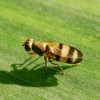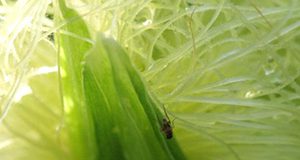Phorid flies (Diptera), also known as humpback flies or scuttle flies for their appearance and behavior, are an extremely diverse group of flies that are saprophagous (feed on decaying organic matter), parasitic, or phytophagous (feed on plants). Within the Phoridae family, the genus Megaselia is also extremely diverse, with more than 1400 described species, many very similar in appearance. The name “cob fly” was given to a Megaselia spp. that attacked corn in Texas. This 5-page fact sheet written by David Owens, Gregg S. Nuessly, Robert Beiriger, and Nicholas Larsen and published by the Department of Entomology and Nematology describes the distribution of this pest, ways to distinguish it from other similar corn ear pests, its life cycle, the damage it causes, and some strategies for management.
http://edis.ifas.ufl.edu/in1144
Tag: Gregg S. Nuessly
Cornsilk Fly (suggested common name), Euxesta stigmatias Loew (Insecta: Diptera: Otitidae) (EENY224/IN381)
 ‘Cornsilk flies’ are attractive, medium to dark metallic green to black colored flies with distinctive wing patterns and wing flapping behavior. They are commonly found throughout Florida’s agricultural communities. Their normally saprophytic life style belies their destructive nature when it comes to their preference for sweet corn ears. Four species of ‘cornsilk flies’ are known to attack corn in Florida: Chaetopsis massyla (Walker), Euxesta annonae (Fabricius), Euxesta eluta Loew, and Euxesta stigmatias Loew. This 8-page fact sheet was written by Gregg S. Nuessly and John L. Capinera, and published by the UF Department of Entomology and Nematology, April 2013. #UFBugs
‘Cornsilk flies’ are attractive, medium to dark metallic green to black colored flies with distinctive wing patterns and wing flapping behavior. They are commonly found throughout Florida’s agricultural communities. Their normally saprophytic life style belies their destructive nature when it comes to their preference for sweet corn ears. Four species of ‘cornsilk flies’ are known to attack corn in Florida: Chaetopsis massyla (Walker), Euxesta annonae (Fabricius), Euxesta eluta Loew, and Euxesta stigmatias Loew. This 8-page fact sheet was written by Gregg S. Nuessly and John L. Capinera, and published by the UF Department of Entomology and Nematology, April 2013. #UFBugs
http://edis.ifas.ufl.edu/in381
Lesser Cornstalk Borer Damage to Sugarcane and the Effects of Tillage and Harvest Residue Management (ENY454/SC094)
 This 6-page fact sheet provides an overview of this pest, its damage to sugarcane, and the plant’s response, and describes the results of a study of harvest residue and controlled tillage experiments. Written by Hardev S. Sandhu, Leslie E. Baucum, and Gregg S. Nuessly, and published by the UF Department of Entomology and Nematology, May 2012.
This 6-page fact sheet provides an overview of this pest, its damage to sugarcane, and the plant’s response, and describes the results of a study of harvest residue and controlled tillage experiments. Written by Hardev S. Sandhu, Leslie E. Baucum, and Gregg S. Nuessly, and published by the UF Department of Entomology and Nematology, May 2012.
http://edis.ifas.ufl.edu/sc094
Life Cycle of the Lesser Cornstalk Borer in Sugarcane (ENY913/SC093)
 The lesser cornstalk borer attacks a large number of crops, but is a potentially serious pest of sugarcane. But since the populations of this pest vary greatly depending on temperature, UF/IFAS scientists are developing predictive models to predict lesser cornstalk borer population in field. This 4-page fact sheet was written by H.S. Sandhu, L.E. Baucum, and G.S. Nuessly and published by the UF Department of Entomology and Nematology, September 2011.
The lesser cornstalk borer attacks a large number of crops, but is a potentially serious pest of sugarcane. But since the populations of this pest vary greatly depending on temperature, UF/IFAS scientists are developing predictive models to predict lesser cornstalk borer population in field. This 4-page fact sheet was written by H.S. Sandhu, L.E. Baucum, and G.S. Nuessly and published by the UF Department of Entomology and Nematology, September 2011.
http://edis.ifas.ufl.edu/sc093
ENY658/IN401 Managing Thrips in Pepper and Eggplant
Revised! ENY-658, a 6-page illustrated fact sheet by Joe Funderburk, Stuart Reitz, Phil Stansly, Dave Schuster, Greg Nuessly, and Norm Leppla, provides pepper and eggplant growers with management information for this serious pest of ornamental, vegetable and fruit crops in the field and greenhouse — biology and ecology, tomato spotted wilt and management programs. Includes references. Published by the UF Department of Entomology and Nematology, October 2009.
http://edis.ifas.ufl.edu/IN401
EENY435/IN789 Corn blotch leafminer Agromyza parvicornis Loew (Insecta: Diptera: Agromyzidae)
EENY-435, a 4-page illustrated fact sheet by Gaurav Goyal and Gregg S. Nuessly, is part of the Featured Creatures collection. It describes this minor and sporadic pest of corn, its distribution, description and life cycle, host plants, economic importance, and management. Includes references. Published by the UF Department of Entomology and Nematology, June 2008.
http://edis.ifas.ufl.edu/IN789
